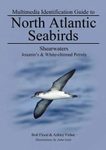![Manx Shearwater Puffinus puffinus Evening Rafting Behaviour Around Colonies on Skomer, Rum and Bardsey Manx Shearwater Puffinus puffinus Evening Rafting Behaviour Around Colonies on Skomer, Rum and Bardsey]()
Click to have a closer look
About this book
Related titles
About this book
The EU Birds Directive (79/409/EEC) provides a legislative framework for the protection, management and control of naturally occurring wild birds of EU Member States. As part of the implementation of the Birds Directive in the UK, JNCC is currently undertaking work to contribute to the identification of the most suitable areas for consideration as Special Protection Areas (SPAs) for birds in the marine environment. This work is being carried out on behalf of UK government and the nature conservation agencies (Natural England (NE), Scottish Natural Heritage (SNH), Countryside Council for Wales (CCW), and, in Northern Ireland, the Council for Nature Conservation and the Countryside (CNCC).
One strand of this work is the identification of seaward extensions to existing seabird breeding colony SPA boundaries, which are currently bound by the mean low water mark (mean low water springs in Scotland). This report presents recommendations in support of setting of site-specific seaward boundary extensions to three SPAs which have been designated for their internationally important concentrations of Manx shearwaters Puffinus puffinus, namely the Skomer and Skokholm SPA, Rum SPA, and Glannau Aberdaron and Ynys Enlli/Aberdaron Coast and Bardsey Island SPA. These SPAs include the UK's three largest Manx shearwater colonies, together hosting up to 90% of the world's population.
Any seaward boundary extension to an existing seabird colony SPA should include marine areas on which the existing interest feature (in this case, breeding Manx shearwaters), are ecologically dependent. Breeding Manx shearwaters regularly form aggregations at sea (called rafts), up to 10km from the colony shore in the evening, prior to coming ashore to feed the chick after night-fall. Although the function of rafting is not known for certain, it is clearly an important behaviour, given the number of birds that engage in it, and the fact that rafts are regularly formed around the colony. It is not possible to use conventional visual survey techniques to assess the locations of rafting birds (primarily because rafts are formed in the evening through to nightfall). This report describes work using radio-telemetry to locate key areas used regularly in the evening by rafting Manx shearwaters around the three breeding colonies of Skomer (south-west Wales), Rum (western Scotland) and Bardsey (west Wales).
Fieldwork was carried out between July and August, in 2003 (Skomer), 2004 (Rum) and 2005 (Bardsey), with radio-tags fitted to 30, 28 and 30 breeding adults at each colony respectively. Radio-tracking was carried out from early evening until birds returned to their colonies after nightfall, and locations of rafting birds were generated through analysis of radio-tracking data. Radio-tracking was found to be an appropriate and useful way of determining the spatial extent of Manx shearwater rafts, although there were some limitations to the data. The growth of chicks from tagged adults over the study period indicated that radio-tags did not significantly affect the adult's ability to adequately provision their chick on Bardsey or Skomer, but may have done to a small extent on Rum.
Based on kernel analysis of the rafting locations of tagged birds, we recommend a seaward boundary extension of 4km for Skomer and Skokholm SPA, 6km for Rum SPA and 9km for the Bardsey Island part of the Glannau Aberdaron and Ynys Enlli/Aberdaron Coast and Bardsey Island SPA. For any other SPA for which Manx shearwater is a designated feature, we recommend a seaward boundary extension of at least 4km, or possibly further if future investigation suggests so.
Customer Reviews























![The Book of Pelicans [English / Greek]](http://mediacdn.nhbs.com/jackets/jackets_resizer_medium/14/140609.jpg?height=150&width=125)

